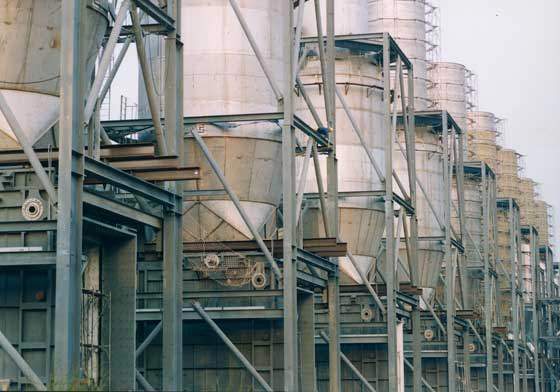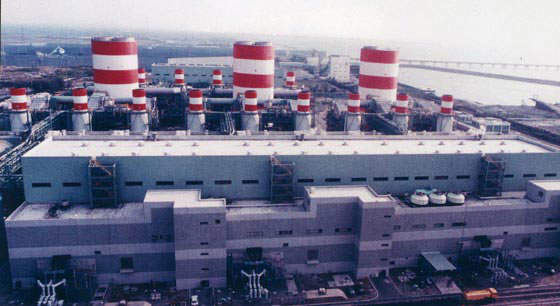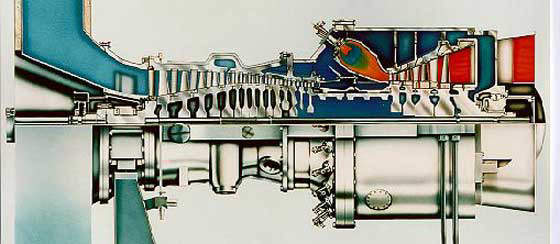Thought to be valued at more than $1bn, the Hsinta natural gas-fired combined-cycle project is Taipower’s largest gas-fired investment to date. The 2,410MW combined-cycle installation was designed for peak and intermediate load generation. The power is supplied by five 442MW (net) powertrains, each comprising three gas turbines with HRSG and one steam turbine.
The project is based in the southwestern port city of Kaohsiung and has been built next to an existing 2,100MW coal and oil-fired plant completed in the 1980s. The project’s five units came online consecutively between 1998 and 1999.
Hsinta is the central element of the fuel diversification strategy and emission reduction programme, which followed the first wave of oil, coal and nuclear investment in the 1970s and 1980s.
In 1995, the first flue gas desulfurisation retrofit ever undertaken in Taiwan was completed on Units 1 and 2. In 2000, a demonstration predictive emission monitoring system (PEMS) was installed on Hsinta Unit 1.
Taipower runs Taiwanese power generation
The state-run Taiwan Power Company (Taipower) is responsible for production and distribution of electric power in Taiwan. Nearly two-thirds of all power generated is used by industry. Taipower’s annual operating revenues are more than $9bn and the company employs 25,000 people.
The Ministry of Economic Affairs (MOEA) has promoted the opening of the market to Independent Power Producers (IPPs). This happened in four stages – in January 1995, August 1995, January 1999, and June 2006. Under government policy, industrial plants operated by private corporations have also been encouraged to develop cogeneration systems and to sell their surplus power to Taipower.
Taipower has, therefore, made few developments in recent years and the proportion of reserve capacity has remained around the 10% level since 1990, far from the desired 15-20%. By the end of 2006, Taipower had a total of 74 power plants, of which 39 were hydropower, 27 thermal, three nuclear and five windpower.
The total installed capacity was 30,045MW, of which 15% was hydro, 31% coal-fired, 12% oil-fired, 25% gas-fired, and 17% nuclear. The peak load in 2006 was 32,060MW, a 3.6% increase over 2005, and the average load was 21,886MW, a 3.5% increase from 2005.
Five 442MW powertrains
Initial plant orders were placed in 1994. The configuration adopted was five 442MW (net) powertrains, each comprising three gas turbines with HRSGs and a steam turbine.
Siemens won the main equipment contract. The company had previously won the Taipower 855MW combined-cycle power plant in Nan Pu, which was completed in 1997. In addition, Taipower also placed a turnkey order with Siemens for its Linkou 296MW gas turbine power plant. Siemens supplied close to 3,500MW in gas capacity to Taipower in the 1990s. Siemens’ presence in Taiwan dates back to the late 1960s and the company employs over 800 people there.
FGD units were retrofitted by Gibsin after ten years of operation to meet stringent emission regulations, especially SOx limits. In addition to the one full-flow SO2 scrubber train with removal efficiency of 90%, a pre-scrubber reduces the particulates down to 34mg/Nm³ without major modification of existing electrostatic precipitator. Non-leakage type instead of Ljunstrom gas-gas heater was adopted to meet emission standards.
Gas turbines
Siemens’ scope of supply covered 15 103MW gas turbines, five 173MW steam turbines, 15 heat recovery steam generators and power generators. The order was probably worth around $500m. Siemens Power Corp in Milwaukee, Wisconsin, supplied the gas turbines, while the steam turbines and generators were manufactured at the Siemens’ plant in Mülheim, Germany. Taiwanese companies carried out most of the general engineering and construction work, which was supervised by Siemens’ Taiwan engineers.
Siemens also supplied process control systems and other electrical equipment. The control package featured a separate Teleperm ME system controlling each gas turbine. The units, operating under Windows 3.11, were linked with Siemens CS275 bus. NEM Group supplied the vertical, forced circulation HRSGs with two pressure levels. The company subcontracted many of the boiler supplies to Taiwanese companies.
In 2000, Taipower and National Cheng Kung University tested one of the first demonstration PEMS in Taiwan. The system was installed on Unit 1 of Hsinta.
To optimise the NOx PEMS model, several functions were progressively developed, including a log model, a one-level linear model, a three-level linear model, a 15-variable linear model, and a 15-variable with start-up mode model.
LNG fuel supply
The China Petroleum Corporation (CPC) supplies fuel for Hsinta power station from its nearby Yung An LNG receiving terminal. The Taiwan Government approved plans for a major expansion of the Yung An terminal in 1997. Completion of Yung An phase two was timed to coincide with the completion of the first gas-fired combined-cycle unit at Hsinta. LNG is supplied from Malaysia under CPC’s second long-term LNG contract with that country.
Yung An terminal, Taiwan’s only LNG import facility was expanded to handle nine million tonnes per year. At the time of construction, CPC needed two more long-term LNG supply contracts and was talking to producers in Malaysia, Indonesia, Qatar, Yemen, Australia and Alaska.
Taipower has contracted with the China Petroleum Corporation for the purchase of up to 3.4 million tonnes of LNG per year and proposes to secure its own LNG requirements beyond this level. It is expected that Taipower might become joint venture partners in a private sector LNG terminal development. Taiwan’s Tuntex Corporation has proposed to build a $2bn LNG terminal in Tatan in the north of the island. The terminal handles six million tonnes of LNG a year.






